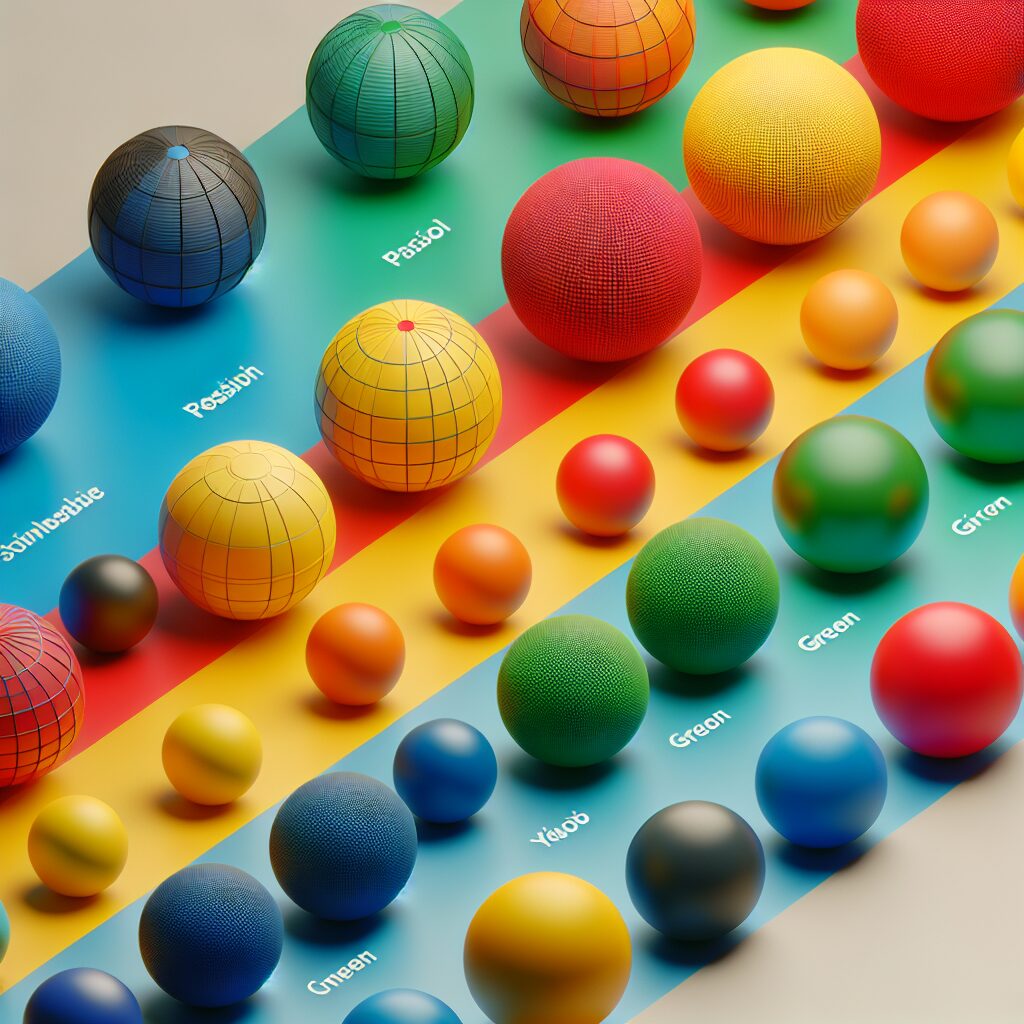Hand-Sewn Ball Construction: The Mark of Quality
In the world of sports, one cannot deny the significance of the ball. It is the fundamental tool that determines the outcome of a game, whether it’s soccer, basketball, or volleyball. But have you ever wondered what sets apart a high-quality ball from the rest? The answer lies in the hand-sewn ball construction, which guarantees superior performance and durability. By hand-stitching every seam with utmost precision and care, this method elevates the overall quality of the ball, enhancing its bounce, grip, and overall feel.
When it comes to hand-sewn ball construction, each stitch is a testament to craftsmanship and attention to detail. Unlike their machine-stitched counterparts, hand-sewn balls have a distinct advantage. They offer exceptional durability, ensuring that the ball can withstand the rigorous demands of intense gameplay. Additionally, the hand-stitching technique allows for greater accuracy and consistency in the ball’s shape and size. This, in turn, results in a more predictable and stable flight trajectory, giving players better control and accuracy in their shots.
As we delve deeper into the world of hand-sewn ball construction, the following sections will discuss the key takeaways that highlight the benefits and impact of this technique. From the enhanced grip to the durability that withstands the test of time, each aspect contributes to the superior performance of hand-sewn balls. So, let’s unravel the secrets behind this mark of quality, and discover how it revolutionizes the world of sports.
Key Takeaways
1. Hand-sewn ball construction is considered a mark of quality in the sporting goods industry, as it offers superior durability and performance compared to machine-stitched counterparts.
2. The meticulous process involved in hand-sewn ball construction requires highly skilled craftsmanship, as every stitch is carefully executed to ensure precision and consistency.
3. Hand-sewn balls are often assembled using multiple layers of high-quality materials, such as synthetic leather or coated textiles, resulting in enhanced grip, control, and overall ball stability.
4. The longer production time and increased labor costs associated with hand-sewn balls contribute to their higher price point, but many athletes and professionals recognize their long-term value and performance benefits.
5. Hand-sewn ball construction has a rich history that dates back centuries, and its artisanal nature continues to appeal to those who appreciate the artistry and tradition behind the creation of high-quality sporting equipment.
Is Hand-Sewn Ball Construction the Mark of Quality? Exploring the Benefits and Techniques
1. Understanding Hand-Sewn Ball Construction
Hand-sewn ball construction refers to the traditional method of creating sports balls by stitching them together manually. This technique is often associated with superior quality and craftsmanship. In this section, we will delve into the details of this construction method.
2. The Benefits of Hand-Sewn Ball Construction
Hand-sewn ball construction offers numerous advantages over other manufacturing techniques. By focusing on this technique, you can guarantee a high-quality product that meets the expectations of athletes and sports enthusiasts alike. Let’s explore the benefits in depth.
2.1 Durability and Longevity
Hand-sewn balls are known for their exceptional durability. The meticulous stitching and choice of materials contribute to a ball that can withstand rigorous play and maintain its integrity over time.
2.2 Enhanced Control and Feel
Hand-sewn construction allows for precise stitching patterns, resulting in a ball that offers improved control and feel. Athletes can sense the ball’s movement more accurately and experience enhanced performance.
2.3 Customizability
With hand-sewn construction, manufacturers have greater flexibility in designing and customizing sports balls. This enables them to cater to the specific needs and preferences of athletes, ensuring the perfect fit for various sports disciplines.
3. The Techniques Behind Hand-Sewn Ball Construction
Creating a high-quality hand-sewn ball requires skill, precision, and attention to detail. In this section, we will explore the techniques involved in this construction method, giving you an insight into the craftsmanship behind the process.
3.1 Pattern Design
Before any stitching takes place, expert craftspeople meticulously design the pattern that will shape the ball. This involves careful consideration of factors such as the number and placement of panels, optimizing aerodynamics and overall performance.
3.2 Stitching Process
The stitching process is where the magic happens. Skilled craftspeople use specialized tools and techniques to ensure each stitch is precise and secure. This stage demands a high level of craftsmanship and expertise to achieve the desired ball structure.
3.3 Material Selection
Choosing the right materials is crucial for hand-sewn ball construction. From the outer cover to the inner layers, each component should be carefully selected to provide the optimal combination of durability, shape retention, and performance.
4. Care and Maintenance for Hand-Sewn Balls
To prolong the life and performance of hand-sewn balls, proper care and maintenance are essential. Here, we provide valuable tips on how to take care of these specialized sports balls.
- Store the ball in a clean and dry environment to prevent moisture damage.
- Avoid exposing the ball to extreme temperature conditions, as this can affect its performance.
- Regularly inspect the stitching for any signs of wear or loose threads, and repair as necessary.
- Clean the ball using a soft cloth and mild detergent, ensuring gentle and thorough cleaning without damaging the stitching.
- When not in use, consider covering the ball with a protective case or bag to prevent unnecessary wear and tear.
Final Word:
Hand-sewn ball construction has long been considered the mark of quality in the sports industry. Its benefits, techniques, and care requirements make it a preferred choice for athletes and sports enthusiasts seeking superior performance and longevity. By understanding the intricacies of hand-sewn ball construction and following the necessary maintenance practices, you can enjoy the exceptional quality and satisfaction that these balls offer.
Frequently Asked Questions
1. What is hand-sewn ball construction?
Hand-sewn ball construction refers to the method of manufacturing a ball where each panel is stitched together by hand. This meticulous process ensures superior quality and durability.
2. How is hand-sewn ball construction different from machine-sewn construction?
Unlike machine-sewn construction, hand-sewn ball construction involves skilled craftsmen meticulously stitching each panel together by hand. This results in a ball that offers better performance, a more consistent flight, and enhanced control.
3. Does hand-sewn ball construction affect the feel of the ball?
Yes, hand-sewn ball construction significantly affects the feel of the ball. The precise stitching and attention to detail create a softer touch and a better grip, allowing players to have a greater level of control during gameplay.
4. Are hand-sewn balls more expensive?
Hand-sewn balls are generally more expensive compared to machine-sewn ones. The craftsmanship involved and the quality of materials used contribute to the higher cost. However, the durability and performance they offer make them worth the investment for serious players.
5. Are hand-sewn balls suitable for professional use?
Hand-sewn balls are highly suitable for professional use. Their superior construction ensures consistent flight, accurate trajectory, and enhanced control, making them a preferred choice among professional players in various sports.
6. Do hand-sewn balls last longer than machine-sewn ones?
Yes, hand-sewn balls tend to last longer than machine-sewn ones. The meticulous stitching and high-quality materials used in hand-sewn ball construction result in a more durable product that can withstand rigorous use and maintain its performance for an extended period.
7. Can hand-sewn ball construction affect performance in different sports?
Hand-sewn ball construction can positively impact performance in various sports. Whether it’s soccer, basketball, or volleyball, the precision stitching of a hand-sewn ball provides players with improved control, better grip, and more accurate flight, enhancing their overall performance.
8. Are there any disadvantages to hand-sewn ball construction?
While hand-sewn ball construction offers numerous advantages, one potential disadvantage is the higher price compared to machine-sewn balls. Additionally, the intricate stitching may take longer to complete, resulting in longer production times.
9. Can hand-sewn balls be customized?
Yes, hand-sewn balls can often be customized. Many manufacturers offer the option to personalize the design, colors, and logos on the ball, allowing teams or individuals to have a unique ball that represents their brand or style.
10. How can I ensure the hand-sewn ball I purchase is of high quality?
To ensure you’re purchasing a high-quality hand-sewn ball, consider reputable brands known for their craftsmanship. Look for balls made from durable materials, check customer reviews, and if possible, compare the ball’s weight, size, and construction to other trusted options on the market.
Final Thoughts
The art of hand-sewn ball construction is a testament to the pursuit of excellence in sporting equipment. The attention to detail, precision stitching, and quality materials used create a product that sets itself apart from machine-sewn alternatives. Choosing a hand-sewn ball is not just an investment in superior performance, but an embodiment of the commitment to the sport and the desire for the highest level of quality.
Whether you’re a professional athlete, an avid sports enthusiast, or simply someone who appreciates the craftsmanship, opting for a hand-sewn ball construction is a decision that can elevate your game and enhance your overall playing experience. Embrace the mark of quality and unlock your full potential on the field, court, or pitch.




